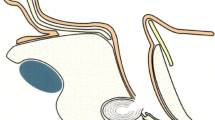Abstract
The primary aim of surgery for cholesteatoma is to eliminate the disease, to produce a safe and dry ear which is self cleansing, modify the anatomy of the tympanomastoid compartment so as to prevent recurrent disease and wherever possible to reconstruct the hearing mechanism. The advances in medical technology and the medical expertise gained over a period of time have greatly influenced the results in cholesteatoma surgery. The aim of the present study was to assess the intraoperative findings during revision mastoid surgery for atticoantral disease and to ascertain the preventable factor that could reduce recurrence. A retrospective analysis of all clinical data and operative notes of patients who had undergone revision surgery for recurrent cholesteatoma, in our unit in a tertiary care centre in south India over a period of 3 years from July 2007 to July 2010 was done. 33 patients had undergone revision mastoid surgery for cholesteatoma. Most patients presented with symptoms and sign of disease about 2 years after the first surgery. The commonest complaint was recurrent foul smelling ear discharge. The most frequent site of recurrent cholesteatoma was the tip cells (72%) and the most important cause for failure of surgery with recurrence of disease was inadequate meatoplasty (70%). In our study, recurrent disease was likely due to cholesteatoma in the tip cells left uncleared and inadequate meatoplasty. Both these issues reflect faulty techniques in performing good meatoplasty or the tip cell are not adequately reduced into the external auditory canal. Bone work is generally taught well in all temporal bone workshops but no emphasis is laid on soft tissue work hence the failure and recurrence. Thus we emphasize the need to teach the budding otologists the importance of and proper technique of meatoplasty.








Similar content being viewed by others
References
Sadoghi M, Dabirmoghaddam P (2007) Intraoperative findings in revision mastoid surgery. Acta Med Iran 45(5):373–376
Nadol JB Jr (1985) Causes of failure of mastoidectomy for chronic otitis media. Laryngoscope 95:410–413
Megerian CA, Cosenza MJ, Meyer SE (2002) Revision tympanomastoid surgery. Ear Nose Throat J 81:718–720, 722, 725–726
Sheehy JL (1978) Recurrent and residual disease in cholesteatoma surgery. Clin Otolaryngol Allied Sci 3(4):393–403
Farrior JB, Farrior KA (1985) Recurrent & residual cholesteatoma. Am J Otol 6:13–18
Toner JG, Smyth GDL (1990) Surgical treatment of cholesteatoma: a comparison of three techniques. Am J Otol 11(4):247–249
Veldman JE, Braunius WW (1998) Revision surgery for chronic otitis media: a learning experience. Report on 389 cases with a long-term follow-up. Ann Otol Rhinol Laryngol 107:486–491
Bhatia S, Karmarkar S, DeDonato G, Mutlu C, Taibah A, Russo A et al (1995) Canal wall down mastoidectomy: causes of failure; pitfalls and their management. J Laryngol Otol 109:583–589
Author information
Authors and Affiliations
Corresponding author
Rights and permissions
About this article
Cite this article
Prasanna Kumar, S., Ravikumar, A. & Somu, L. Modified Radical Mastoidectomy: A Relook at the Surgical Pitfalls. Indian J Otolaryngol Head Neck Surg 65 (Suppl 3), 548–552 (2013). https://doi.org/10.1007/s12070-011-0466-5
Received:
Accepted:
Published:
Issue Date:
DOI: https://doi.org/10.1007/s12070-011-0466-5




